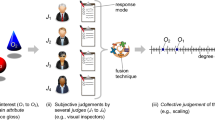Abstract
The authors recently presented a technique (denominated “ZM”) to fuse multiple (subjective) preference rankings of some objects of interest—in manufacturing applications—into a common unidimensional ratio scale Franceschini and Maisano J Intell Manuf, 2019. Although this technique can be applied to a variety of decision-making problems in the manufacturing field, it is limited by a response mode requiring the formulation of complete preference rankings, i.e., rankings that include all objects. Unfortunately, this model is unsuitable for some practical contexts—such as decision-making problems characterized by a relatively large number of objects and field surveys—where respondents can barely identify the more/less preferred objects, without realistically being able to construct complete preference rankings. The purpose of this paper is to develop a new technique (denominated “ZMII”) which also “tolerates” incomplete preference rankings, e.g., rankings with the more/less preferred objects only. This technique borrows the underlying postulates from the Thurstone’s Law of Comparative Judgment and uses the Generalized Least Squares method to obtain a ratio scaling of the objects of interest, with a relevant uncertainty estimation. Preliminary results show the effectiveness of the new technique even for relatively incomplete preference rankings. Description is supported by an application example concerning the design of a coach-bus seat.
Similar content being viewed by others
References
Franceschini F, Maisano D (2019) Adapting Thurstone’s Law of Comparative Judgment to fuse preference orderings in manufacturing applications. J Intell Manuf. https://doi.org/10.1007/s10845-018-1452-5
Keeney RL, Raiffa H (1993) Decisions with multiple objectives: preferences and value trade-offs. Cambridge University Press, Cambridge
Coaley K (2014) An introduction to psychological assessment and psychometrics, 2nd edn. Sage, London
Nahm YE, Ishikawa H, Inoue M (2013) New rating methods to prioritize customer requirements in QFD with incomplete customer preferences. Int J Adv Manuf Technol 65(9-12):1587–1604
Lin CJ, Cheng LY (2017) Product attributes and user experience design: how to convey product information through user-centered service. J Intell Manuf 28(7):1743–1754
Zheng P, Xu X, Xie SQ (2019) A weighted interval rough number based method to determine relative importance ratings of customer requirements in QFD product planning. J Intell Manuf 30:459–416. https://doi.org/10.1007/s10845-016-1224-z
Çakır S (2018) An integrated approach to machine selection problem using fuzzy SMART-fuzzy weighted axiomatic design. J Intell Manuf 29(7):1433–1445
Hosseini S, Al Khaled A (2016) A hybrid ensemble and AHP approach for resilient supplier selection. J Intell Manuf 30:207–228. https://doi.org/10.1007/s10845-016-1241-y
Wang GX, Huang SH, Yan Y, Du JJ (2017) Reconfiguration schemes evaluation based on preference ranking of key characteristics of reconfigurable manufacturing systems. Int J Adv Manuf Technol 89(5-8):2231–2249
DeVellis RF (2016) Scale development: theory and applications, 4th edn. Sage, London
Franceschini F, Galetto M, Maisano D (2019) Designing performance measurement systems: theory and practice of key performance indicators. Springer Nature, Berlin
Harzing AW, Baldueza J, Barner-Rasmussen W, Barzantny C, Canabal A, Davila A, Espejo A, Ferreira R, Giroud A, Koester K, Liang YK, Mockaitis A, Morley MJ, Myloni B, Odusanya JOT, O’Sullivan SL, Palaniappan AK, Prochno P, Roy Choudhury S, Saka-Helmhout A, Siengthai S, Viswat L, Uzuncarsili Soydas A, Zander L (2009) Rating versus ranking: What is the best way to reduce response and language bias in cross-national research? Int Bus Rev 18(4):417–432
Edwards AL (1957) Techniques of attitude scale construction. Irvington Publishers, New York
Vanacore A, Marmor YN, Bashkansky E (2019) Some metrological aspects of preferences expressed by prioritization of alternatives. Measurement 135:520–526
Thurstone LL (1927) A law of comparative judgments. Psychol Rev 34(4):273–286
Roberts FS (1979) Measurement theory: with applications to decision-making, utility, and the social sciences, Encyclopaedia of Mathematics and its Applications, vol. 7. Addison-Wesley, Reading
Nederpelt R, Kamareddine F (2004) Logical Reasoning: A First Course. King’s College Publications, London
Lagerspetz E (2016) Social choice and democratic values. Springer, Heidelberg
Montag ED (2006) Empirical formula for creating error bars for the method of paired comparison. J Electron Imaging 15(1):010502
Alvo M, Cabilio P (1991) On the balanced incomplete block design for rankings. Ann Stat 19:1597–1613
González-Pachón J, Romero C (2001) Aggregation of partial ordinal rankings: an interval goal programming approach. Comput Oper Res 28(8):827–834
Gulliksen H, Tucker LR (1961) A general procedure for obtaining paired comparisons from multiple rank orders. Psychometrika 26(2):173–183
Kendall (1963) Rank correlation methods. Griffin & C, London
Vincke P (1982) Aggregation of preferences: a review. Eur J Oper Res 9(1):17–22
Kariya T, Kurata H (2004) Generalized least squares. John Wiley & Sons, New York
Kowalska M, Pazdzior M, Krzton-Maziopa A (2018) Implementation of QFD method in quality analysis of confectionery products. J Intell Manuf 29(2):439–447
Franceschini F, Maisano D (2015) Prioritization of QFD customer requirements based on the law of comparative judgments. Qual Eng 27(4):437–449
Franceschini F, Maisano D, Mastrogiacomo L (2015) Customer requirement prioritization on QFD: a new proposal based on the generalized Yager’s algorithm. Res Eng Des 26(2):171–187
Gulliksen H (1956) A least squares solution for paired comparisons with incomplete data. Psychometrika 21:125–134
Paruolo P, Saisana M, Saltelli A (2013) Ratings and rankings: voodoo or science? J R Stat Soc A Stat Soc 176(3):609–634
Ross SM (2014) Introduction to probability and statistics for engineers and scientists. Academic Press, Amsterdam
Lenartowicz T, Roth K (2001) Does subculture within a country matter? A cross-cultural study of motivational domains and business performance in Brazil. J Int Bus Stud 32(2):305–325
Fahandar MA, Hüllermeier E, Couso I (2017). Statistical inference for incomplete ranking data: the case of rank-dependent coarsening. arXiv preprint arXiv:1712.01158
Arbuckle J, Nugent JH (1973) A general procedure for parameter estimation for the law of comparative judgement. Br J Math Stat Psychol 26(2):240–260
JCGM 100:2008 (2008) Evaluation of measurement data - guide to the expression of uncertainty in measurement. BIPM, Paris
Box GE, Hunter WG, Hunter JS (1978) Statistics for experimenters. Wiley, New York
Aludaat KM, Alodat MT (2008) A note on approximating the normal distribution function. Appl Math Sci 2(9):425–429
Acknowledgments
This research was partially supported by the award “TESUN-83486178370409 finanziamento dipartimenti di eccellenza CAP. 1694 TIT. 232 ART. 6,” which was conferred by “Ministero dell’Istruzione, dell’Università e della Ricerca.”
Author information
Authors and Affiliations
Corresponding author
Additional information
Publisher’s note
Springer Nature remains neutral with regard to jurisdictional claims in published maps and institutional affiliations.
Rights and permissions
About this article
Cite this article
Franceschini, F., Maisano, D. Fusing incomplete preference rankings in design for manufacturing applications through the ZM II -technique . Int J Adv Manuf Technol 103, 3307–3322 (2019). https://doi.org/10.1007/s00170-019-03675-5
Received:
Accepted:
Published:
Issue Date:
DOI: https://doi.org/10.1007/s00170-019-03675-5




